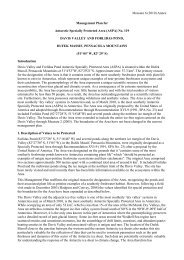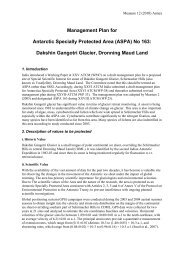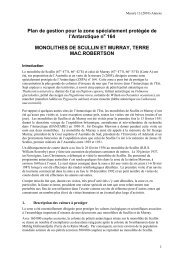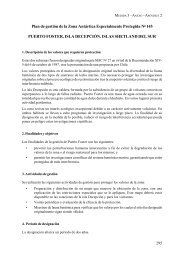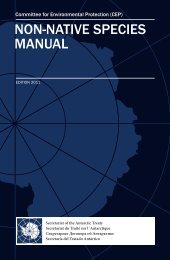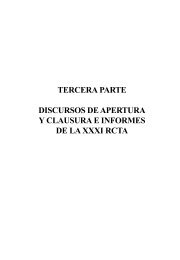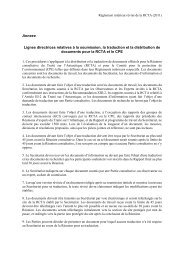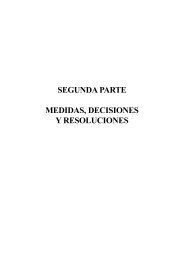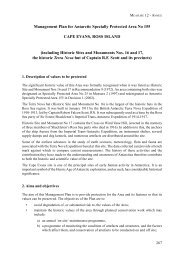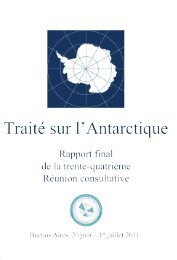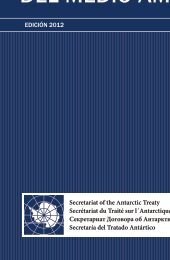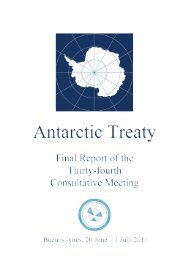Scott Base and McMurdo Station - Antarctic Treaty Secretariat
Scott Base and McMurdo Station - Antarctic Treaty Secretariat
Scott Base and McMurdo Station - Antarctic Treaty Secretariat
Create successful ePaper yourself
Turn your PDF publications into a flip-book with our unique Google optimized e-Paper software.
Exchange of scientific information <strong>and</strong> personnel (Article III)Information about the United States <strong>Antarctic</strong> Program is publicly available <strong>and</strong> readily accessible in printed form<strong>and</strong> through the internet. Scientists from nine <strong>Treaty</strong> States (Australia, Canada, France, Italy, Japan, NewZeal<strong>and</strong>, Pol<strong>and</strong>, Switzerl<strong>and</strong> <strong>and</strong> the United Kingdom) were reported to be present at <strong>McMurdo</strong> during the2004/05 summer. In addition, there were scientists from Mexico <strong>and</strong> Portugal.The results of scientific observations resulting from the United States <strong>Antarctic</strong> Program are published in a rangeof scientific journals.Sovereignty (Article IV)No evidence of territorial activities were observed. The flags of the twelve original signatories to the <strong>Antarctic</strong><strong>Treaty</strong> were flying at the National Science Foundation chalet during the visit of the Australian observer team.Nuclear explosions <strong>and</strong> radioactive waste (Article V)Spent <strong>and</strong> surplus radioactive chemicals used for scientific research are returned to the United States for disposal.No other radioactive materials are present.High seas rights (Article VI)Four vessels associated with the United States <strong>Antarctic</strong> Program were in the vicinity of Ross Isl<strong>and</strong> during thepresence of the Australian observer team. These were the icebreaker USCG Polar Star, the icebreaker Krasin oncharter from FESCO, oceanographic ship RV Nathanial B Palmer, <strong>and</strong> the bulk fuel tanker USNS Paul Buck.We were advised that the bulk dry cargo ship MV American Tern was en route from New Zeal<strong>and</strong>.Conduct of inspections (Article VII)The Australian observer team enjoyed complete freedom of access to all parts of <strong>McMurdo</strong> <strong>Station</strong>. All of ourquestions were answered without hesitation. United States personnel had a good underst<strong>and</strong>ing of the role of<strong>Treaty</strong> inspections <strong>and</strong> cooperated with the observer team at all times.Before departing for <strong>Antarctic</strong>a the Australian observer team had access, via the internet, to detailed informationabout the United States <strong>Antarctic</strong> Program. This information was available in accordance with the agreed formatfor exchange of information. The National Science Foundation greatly facilitated the inspection by also providinginformation in the format of the Inspection Checklists recommended by Resolution 5 (1995) - copy of thisinformation is at Appendix B.Exercise of jursidiction (Article VIII)At the time of the inspection the Australian observer team was subject to an authorisation under sections 12E<strong>and</strong> 12F of Australia’s <strong>Antarctic</strong> <strong>Treaty</strong> (Environment Protection) Act 1980. The personnel of <strong>McMurdo</strong> <strong>Station</strong>recognised that the members of the Australian observer team were subject to Australian jurisdiction whileexercising their functions as observers.4.3 OBSERVATIONS - ENVIRONMENTAL PROTOCOLEnvironmental principles (Article 3)The Australian observer team noted considerable evidence that protection of the <strong>Antarctic</strong> environment <strong>and</strong> itsvalue as an area for the conduct of scientific research are fundamental considerations in the planning <strong>and</strong> conductof the United States <strong>Antarctic</strong> Program. All activities at <strong>McMurdo</strong> <strong>Station</strong> are planned on the basis of informedjudgments about their possible impacts on the <strong>Antarctic</strong> environment. In accordance with the Protocol, priorityis given to scientific research - <strong>and</strong> the major role of <strong>McMurdo</strong> <strong>Station</strong> is facilitating scientific research on RossIsl<strong>and</strong>, in the Ross Sea region <strong>and</strong> elsewhere in <strong>Antarctic</strong>a. In this regard, <strong>McMurdo</strong> operates as the major entrypoint into <strong>Antarctic</strong>a for research supported by the United States at the South Pole <strong>and</strong> other deep field sites onthe high <strong>Antarctic</strong> plateau.Cooperation (Article 6)The United States cooperates closely with other Parties to the Protocol in the planning <strong>and</strong> conduct of its<strong>Antarctic</strong> activities, particularly with New Zeal<strong>and</strong> <strong>and</strong> Italy with whom it contributes to a shared logistics poolfor inter-continental air transport <strong>and</strong> intra-continental helicopter support. These are longst<strong>and</strong>ing arrangementswhich generate considerable efficiencies <strong>and</strong> avoid duplication of support infrastructure. As noted above,scientists from 11 other nations participated in the research at <strong>McMurdo</strong> <strong>Station</strong> during 2004/05.



